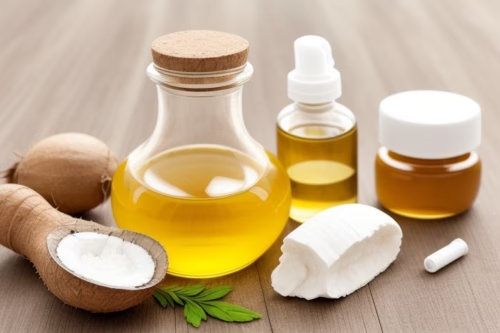
The Silent Struggle of Yeast Infection on Neck
A yeast infection on the neck can be more than just uncomfortable; it can be downright embarrassing and frustrating. Whether it’s caused by excess moisture, friction, or even underlying health conditions, a yeast infection on the neck is a common but often overlooked problem. But don’t worry—there are proven solutions that can help you tackle this condition effectively.

In this guide, we’ll walk you through 7 powerful remedies that can help you treat a yeast infection on your neck and provide relief fast. Whether you’ve experienced it before or suspect you have one now, this article will arm you with the knowledge to take action and start healing.
What Causes Yeast Infection on Neck?
Before diving into treatments, it’s important to understand what causes a yeast infection on the neck. Yeast infections are caused by an overgrowth of Candida, a type of fungus that naturally lives in the body. When the balance of your body’s natural microorganisms is disturbed, Candida can multiply, leading to infections in various areas, including the neck.
Some common causes of yeast infections on the neck include:
- Excessive sweating: Areas where sweat tends to accumulate, like the neck, can create an environment where yeast thrives.
- Friction: Tight clothing or constant rubbing of the neck can increase the likelihood of infection.
- Weak immune system: A compromised immune system makes it harder for your body to control the growth of yeast.
- Poor hygiene: Not cleaning the neck area properly, especially after sweating, can contribute to yeast growth.
- Antibiotic use: Antibiotics can kill off beneficial bacteria, which in turn allows yeast to proliferate.
Now that we know what causes it, let’s explore 7 proven remedies that will help you get rid of that annoying yeast infection.
1. Apply Coconut Oil: The Natural Fighter
Coconut oil is a natural antifungal agent that can help to combat yeast infections on the neck. It contains caprylic acid, which has been shown to fight Candida overgrowth effectively.
- How to use: Gently massage organic coconut oil onto the affected area of your neck twice daily.
- Why it works: Coconut oil not only kills yeast but also helps to soothe the skin, reducing irritation and redness.
Tip: Use pure, unrefined coconut oil for the best results, and make sure to do a patch test first to check for any skin sensitivity.
2. Keep the Area Dry: Yeast Loves Moisture
Moisture creates a perfect breeding ground for yeast, which is why keeping the affected area dry is one of the fastest ways to relieve a yeast infection on your neck. This means avoiding tight clothing that may trap sweat and moisture around your neck.
- Tip: After showering or sweating, make sure to thoroughly dry the neck area. You can even use antifungal powders to absorb excess moisture.
3. Use Apple Cider Vinegar: The Powerful Remedy
Apple cider vinegar (ACV) is well-known for its antifungal properties and can be an effective treatment for yeast infection on the neck. ACV helps balance the pH level of the skin, which makes it harder for yeast to thrive.
- How to use: Mix one tablespoon of apple cider vinegar with two tablespoons of water. Apply the mixture to the affected area with a cotton ball, leave it on for 10 minutes, and then rinse off with warm water.
- Why it works: ACV has natural acids that kill yeast and promote healing.
Pro tip: If you have sensitive skin, dilute the ACV more, and always do a patch test to avoid irritation.
4. Try Antifungal Creams or Ointments
If you’re dealing with a persistent yeast infection on your neck, it might be time to reach for an antifungal cream or ointment. Over-the-counter treatments like clotrimazole or miconazole can help clear up the infection.
- How to use: Apply a small amount of antifungal cream to the infected area as directed on the packaging.
- Why it works: These creams contain antifungal agents that target and kill the yeast causing the infection.
5. Wear Loose Clothing and Breathable Fabrics
Wearing tight clothing or fabrics that don’t allow your skin to breathe can worsen yeast infections. Opting for loose, breathable fabrics like cotton will allow your skin to breathe and reduce friction, giving the infection a chance to heal.
- Tip: Choose loose-fitting shirts and avoid collars that may irritate the infected area.
- Why it works: Cotton absorbs moisture and promotes airflow, reducing the chances of yeast growth.
6. Strengthen Your Immune System
A strong immune system can help combat fungal infections more effectively. Consider incorporating immune-boosting foods into your diet like garlic, ginger, and leafy greens. Additionally, you can try supplements like probiotics, which restore the natural balance of good bacteria in your body.
- Probiotic-rich foods: Yogurt, kefir, kimchi, and sauerkraut.
- Immune-boosting herbs: Echinacea and elderberry can help keep your immune system strong.
7. Consult a Doctor: When to Seek Medical Help
In some cases, over-the-counter treatments and natural remedies may not be enough. If your yeast infection on the neck persists for more than a couple of weeks, or if you experience severe symptoms like intense pain or swelling, it’s important to consult a healthcare professional.
Your doctor can prescribe stronger antifungal medications or investigate underlying conditions that may be contributing to the infection, such as diabetes or a weakened immune system.
Frequently Asked Questions (FAQs)
What are the symptoms of a yeast infection on the neck?
Symptoms may include itching, redness, flaky skin, and painful bumps around the neck area. If you notice any of these signs, it’s important to start treatment immediately.
Can a yeast infection on the neck spread to other parts of the body?
Yes, if left untreated, a yeast infection on the neck can spread to other areas of your body, including the chest and face. Treating it early will help prevent this from happening.
Is there a connection between diet and yeast infections?
Yes, diet plays a significant role in yeast infections. A diet high in sugar can promote yeast growth, while probiotics and anti-inflammatory foods help prevent overgrowth.
Conclusion: Take Action Today for Relief
Dealing with a yeast infection on the neck can be uncomfortable, but the good news is that there are many effective treatments available. By following these 7 proven tips, you can relieve symptoms and prevent future infections. Whether it’s using natural remedies like coconut oil and apple cider vinegar or wearing breathable fabrics, you have the tools to regain control of your health.
Don’t let a yeast infection on the neck disrupt your day-to-day life—take action now, and experience the relief you deserve.
Ready to find out more tips for staying healthy and feeling your best? Subscribe now for more expert advice and health hacks!



